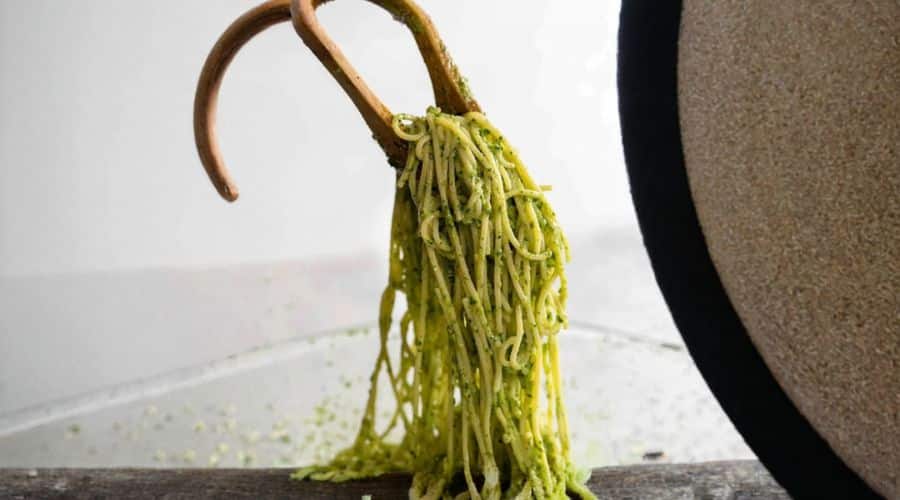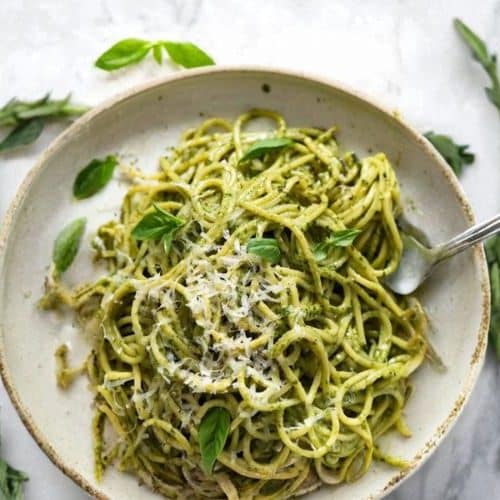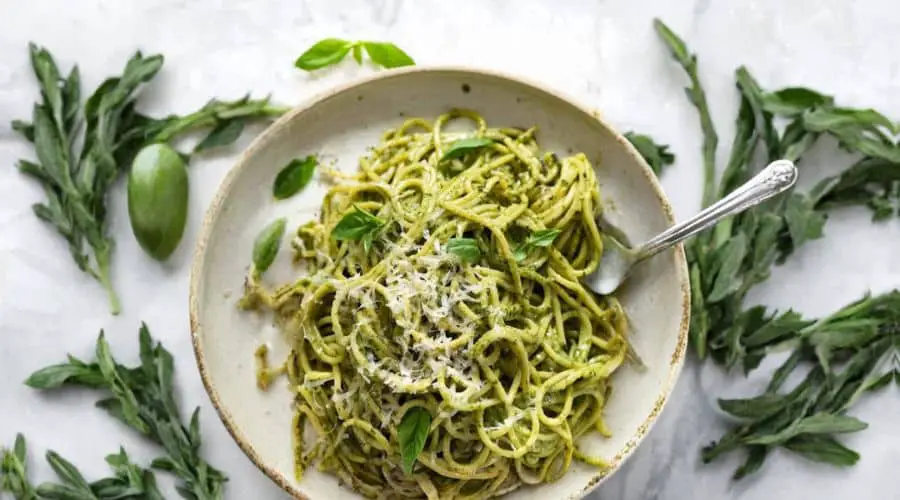This pesto pasta recipe captures the essence of traditional Italian cooking with a simple yet clever technique that transforms ordinary pasta into a luscious, flavorful dish.
The magic lies in using reserved pasta water to blend with the pesto, creating a silky sauce that perfectly coats every strand without excess oil.
This method enhances the texture and ensures a balanced richness that’s satisfying but not greasy.

Nutritionally, this dish shines with fresh basil pesto providing heart-healthy fats from olive oil and pine nuts, along with a modest dose of plant-based protein and fiber from the pasta.
It’s a wholesome meal that feels indulgent yet light.
Its quick preparation and straightforward ingredients make it an ideal choice for busy weeknights or effortless meal prep.
Plus, the recipe’s flexibility allows you to customize pasta types or pesto varieties, making it a versatile staple for any kitchen
Must-Have Tools for Perfect Results
Large Pot
Essential for boiling pasta evenly, a high-quality large pot ensures water reaches a rolling boil quickly and maintains consistent heat, speeding up your cooking process.
Colander
Perfect for draining pasta efficiently without losing any noodles, this kitchen staple helps keep your pasta firm and ready for tossing with sauce.
Mixing Bowl
A spacious bowl allows you to combine pasta, pesto, and reserved cooking water smoothly, ensuring every bite is coated evenly with sauce.
Measuring Cup
Accurate measurement of pasta water is critical for achieving the ideal sauce consistency; a reliable measuring cup helps you add just the right amount of liquid.
Tongs or Pasta Fork
These tools make tossing pasta with sauce effortless, preventing clumping and evenly distributing flavors for a perfect finish every time.

Spaghetti with Basil Pesto
Equipment
- 1 large pot
- 1 colander
- 1 Mixing bowl
- 1 measuring cup
- 1 pair of tongs or pasta fork
Ingredients
- 1 batch homemade pesto or ½ cup store-bought
- 300 to 350 grams pasta ziti, penne, or spaghetti recommended
- 2 teaspoons salt for boiling water
- ¾ cup reserved pasta cooking water
- Parmesan cheese for garnish, to taste
Instructions
- Prepare the Pasta Water with Salt: Begin by filling a large pot with plenty of water—this will ensure the pasta cooks evenly and doesn’t stick together. Place the pot on the stove over high heat and bring the water to a vigorous boil. Once boiling, add 2 teaspoons of salt to the water. The salt seasons the pasta as it cooks, enhancing its natural flavor. Stir gently to dissolve the salt evenly throughout the water.
- Cook the Pasta to Al Dente: Carefully add 300 to 350 grams of your chosen pasta—ziti, penne, or spaghetti all work wonderfully—to the boiling salted water. Stir immediately to prevent the noodles from sticking to each other or the pot. Allow the pasta to cook uncovered, following the timing suggested on the package, usually around 9 to 12 minutes, until the pasta reaches an al dente texture. Al dente means the pasta should be tender but still firm when bitten—this texture will hold up beautifully once combined with the pesto sauce.
- Reserve Pasta Cooking Water: Just before draining the pasta, use a measuring cup or ladle to scoop out approximately ¾ cup of the hot pasta cooking water. This water contains starch released from the pasta, which is crucial for creating a smooth, silky pesto sauce that clings to every noodle. Set this reserved water aside for later use.
- Drain the Pasta Gently: Pour the pasta into a colander placed in the sink to drain off the cooking water. Allow it to sit for about 30 seconds to 1 minute so excess water drips off, but don’t let the pasta sit too long or it may become sticky. Avoid rinsing the pasta, as rinsing washes away the starch needed to bind the sauce.
- Transfer Pasta to a Mixing Bowl: Immediately transfer the drained pasta into a large mixing bowl. Avoid placing the pasta back into the hot cooking pot, as the residual heat can cause the pesto to discolor or wilt prematurely. The bowl provides a perfect environment for tossing and coating the pasta evenly.
- Add Pesto and Pasta Water for Coating: Spoon 1 full batch of homemade pesto (or about ½ cup of store-bought pesto) over the pasta. Pour in about ¼ cup of the reserved pasta water to start. Using tongs or a large spoon, gently toss the pasta and pesto together. The starch-rich water helps emulsify the pesto oil, creating a glossy, silky sauce that clings to every strand. If the pasta looks dry or the sauce feels thick, gradually add more reserved water in small increments, tossing continuously, until you achieve a luxuriously smooth, saucy consistency.
- Taste and Adjust Seasoning: Pause to taste your pesto pasta. The saltiness of the pasta water usually seasons the dish sufficiently, but you may want to add a pinch of salt or freshly ground black pepper to balance the flavors perfectly. For those who enjoy a touch of brightness, a squeeze of fresh lemon juice can be added here to lift the dish.
- Serve Immediately with Parmesan: Once the pasta is coated evenly and seasoned to your liking, serve it right away. Plate the pasta into bowls or onto plates and garnish generously with freshly grated Parmesan cheese. The salty, nutty notes of Parmesan complement the herbal richness of the pesto beautifully.
- Storage and Serving Tips: If you have leftovers, transfer them to a tightly sealed airtight container and refrigerate promptly. Avoid reheating pesto pasta, as heat can cause the basil to darken and the texture to become dull. Instead, bring the pasta to room temperature before serving—the flavors remain vibrant and the dish is just as satisfying cold or at room temperature.
Notes
Chef’s Secrets to Perfect Pasta
The secret to truly exceptional pesto pasta lies in the reserved pasta water.
This starchy water binds the pesto and oil together, creating a creamy sauce that clings to every bite without the need for extra oil or cream.
Using fresh homemade pesto ensures vibrant flavor and a pleasant texture, but even store-bought pesto can be elevated with this technique.
Always use fresh basil for the pesto to preserve its bright green color and fresh taste.
Avoid reheating pesto pasta to prevent the basil from oxidizing and turning dark, which also affects the flavor negatively.
Serving Suggestions for Maximum Enjoyment
This pesto pasta pairs wonderfully with a crisp green salad or roasted vegetables for a balanced meal.
Adding grilled chicken, shrimp, or roasted chickpeas boosts protein content and makes it heartier.
For a burst of acidity and freshness, garnish with a squeeze of lemon juice or a handful of halved cherry tomatoes.
A generous sprinkle of freshly grated Parmesan or Pecorino Romano cheese adds a nutty, savory depth.
Serve it alongside crusty garlic bread to soak up any extra sauce and complete your Italian-inspired meal.
Storage Tips for Best Quality
To store leftover pesto pasta, transfer it into an airtight container and refrigerate promptly.
Because pesto contains fresh basil and olive oil, reheating can cause the sauce to darken and lose its fresh flavor.
Instead, let the pasta come to room temperature before serving again, or enjoy it cold as a refreshing pasta salad alternative.
If you want to store pesto separately, freeze it in ice cube trays for individual portions that can be thawed as needed.
Fresh pesto can also be kept refrigerated for up to one week.
Frequently Asked Questions (FAQs)
1. Can I use store-bought pesto instead of homemade?
Absolutely! Store-bought pesto works well, but it’s often more concentrated. Start with less and add more to taste, adjusting the pasta water accordingly for the perfect sauce consistency.
2. What type of pasta works best with pesto?
Short pasta shapes like ziti, penne, or rigatoni hold pesto nicely, while long strands like spaghetti or linguine also create a classic texture and appearance. Choose based on your preference!
3. Why do I need to reserve pasta water?
Pasta water contains starch that helps emulsify the pesto oil, binding the sauce and pasta together smoothly. This step prevents the sauce from being oily or watery and gives it a silky finish.
4. Can I make this recipe vegan?
Yes! Simply omit the Parmesan cheese or substitute it with a vegan cheese alternative or nutritional yeast for a cheesy flavor without dairy.
5. How should I store leftover pesto pasta?
Store leftovers in an airtight container in the fridge. Avoid reheating to preserve the basil’s bright flavor; instead, bring it to room temperature before eating or enjoy it cold.
This recipe is inspired by recipetineats and has been carefully refined to enhance clarity, streamline preparation steps, and ensure accurate results. We’ve also included health benefits, nutritional highlights, and Must-Have Tools to help you get the best results every time you cook.


